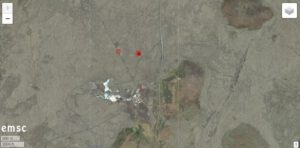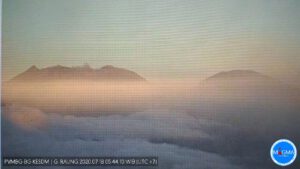 There was another strong earthquake in Iceland this morning. It had a magnitude of 4.1 and manifested itself on the Reykjanes Peninsula. The epicentre was located 4.1 km north of Grindavik and only about 1 km from the Blue Lagoon and Thorbjörn Volcano. The depth of the hypocentre is estimated to be only 2.5 km. This makes it the closest surface earthquake of this magnitude since the swarm earthquakes started on the peninsula. The local residents should have been well shaken. It remains exciting to wait and see whether reports of crevice openings will come in. Just 2 minutes earlier, there was a quake of magnitude 3.2 at a depth of 2.3 km. Further weaker earthquakes followed. In total IMO registered 40 tremors on Reykjanes in the last 48 hours.
There was another strong earthquake in Iceland this morning. It had a magnitude of 4.1 and manifested itself on the Reykjanes Peninsula. The epicentre was located 4.1 km north of Grindavik and only about 1 km from the Blue Lagoon and Thorbjörn Volcano. The depth of the hypocentre is estimated to be only 2.5 km. This makes it the closest surface earthquake of this magnitude since the swarm earthquakes started on the peninsula. The local residents should have been well shaken. It remains exciting to wait and see whether reports of crevice openings will come in. Just 2 minutes earlier, there was a quake of magnitude 3.2 at a depth of 2.3 km. Further weaker earthquakes followed. In total IMO registered 40 tremors on Reykjanes in the last 48 hours.
Day: July 18, 2020
Raung: Eruption started
 On the Indonesian island of Java, the volcano Raung has started an eruption. The eruption was preceded by a seismic crisis. It started on July 13th. The first small ash cloud was detected 2 days ago. A VONA warning was issued and air traffic on the neighbouring island of Bali was suspended. However, due to the corona lockdown, only very few flights may have been affected. In the meantime a stable eruption on a low level has occurred. During the first 6 hours of the day, volcanologists from VSI recorded 28 seismic eruption signals. They had amplitudes between 4 and 14 mm and lasted up to 150 seconds. MIROVA recorded a moderate thermal anomaly with peak values of 15 MW. One can assume strombolian activity, where glowing tephra accumulates in the crater. The alert status has been raised to “yellow.”
On the Indonesian island of Java, the volcano Raung has started an eruption. The eruption was preceded by a seismic crisis. It started on July 13th. The first small ash cloud was detected 2 days ago. A VONA warning was issued and air traffic on the neighbouring island of Bali was suspended. However, due to the corona lockdown, only very few flights may have been affected. In the meantime a stable eruption on a low level has occurred. During the first 6 hours of the day, volcanologists from VSI recorded 28 seismic eruption signals. They had amplitudes between 4 and 14 mm and lasted up to 150 seconds. MIROVA recorded a moderate thermal anomaly with peak values of 15 MW. One can assume strombolian activity, where glowing tephra accumulates in the crater. The alert status has been raised to “yellow.”
The last eruptions of the Raung occurred in 2015, when the eruptions started like now and increased within a few weeks to a very interesting eruption, where not only strombolian eruptions were generated, but also lava flows that filled part of the crater.